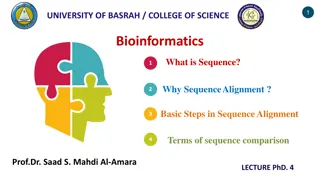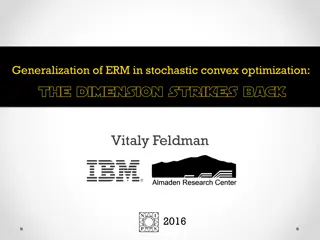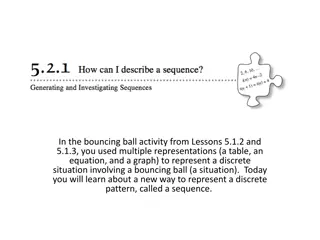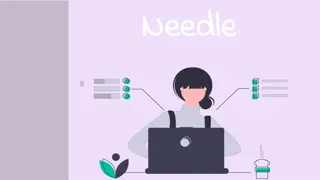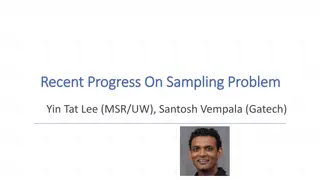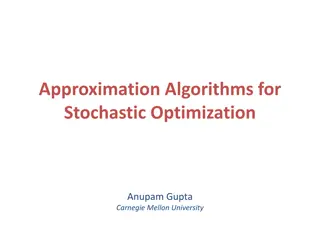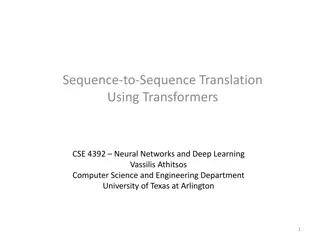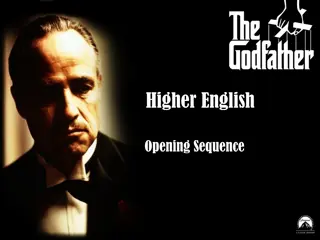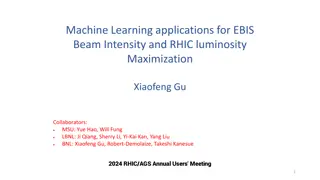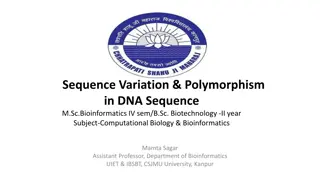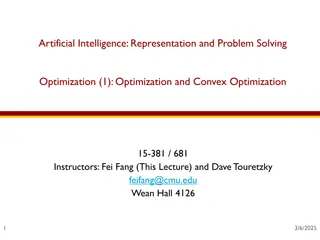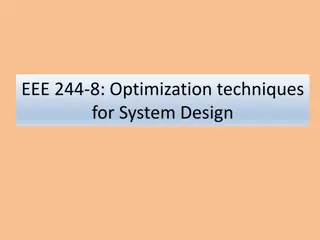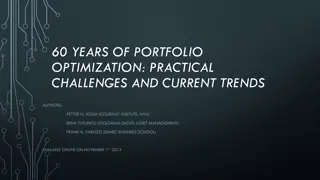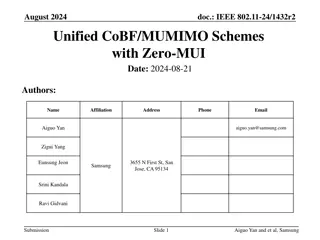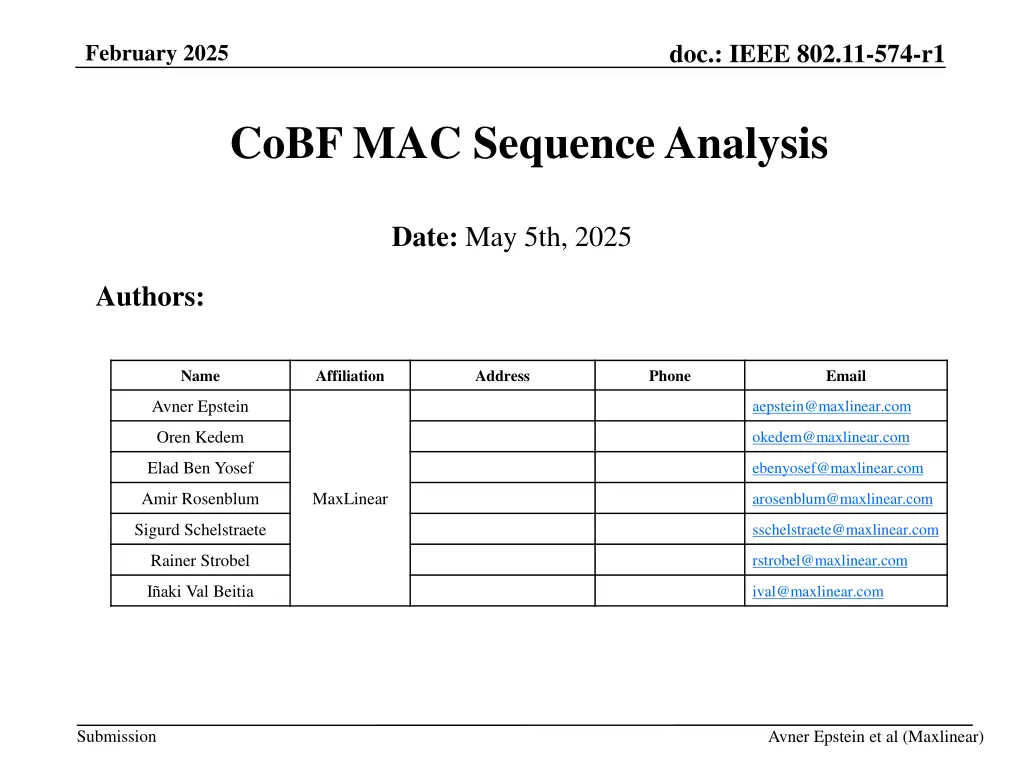
IEEE 802.11-574-r1 CoBF MAC Sequence Analysis
Explore the IEEE 802.11-574-r1 document from February 2025, diving into the Coordinated Beamforming (CoBF) MAC sequence analysis for UHR AP coordination schemes. Understand the use-cases, benefits, and considerations related to CoBF in AP and STA configurations with single antennas. Uncover the implications of enabling or disabling CoBF in maximizing wireless transmission efficiency and performance.
Download Presentation

Please find below an Image/Link to download the presentation.
The content on the website is provided AS IS for your information and personal use only. It may not be sold, licensed, or shared on other websites without obtaining consent from the author. If you encounter any issues during the download, it is possible that the publisher has removed the file from their server.
You are allowed to download the files provided on this website for personal or commercial use, subject to the condition that they are used lawfully. All files are the property of their respective owners.
The content on the website is provided AS IS for your information and personal use only. It may not be sold, licensed, or shared on other websites without obtaining consent from the author.
E N D
Presentation Transcript
doc.: IEEE 802.11-574-r1 February 2025 CoBF MAC Sequence Analysis Date: May 5th, 2025 Authors: Name Affiliation Address Phone Email Avner Epstein aepstein@maxlinear.com Oren Kedem okedem@maxlinear.com Elad Ben Yosef ebenyosef@maxlinear.com Amir Rosenblum MaxLinear arosenblum@maxlinear.com Sigurd Schelstraete sschelstraete@maxlinear.com Rainer Strobel rstrobel@maxlinear.com I aki Val Beitia ival@maxlinear.com Submission Avner Epstein et al (Maxlinear)
doc.: IEEE 802.11-574-r1 February 2025 Introduction CoBF is one of the proposed AP Coordination Schemes for UHR Ref [1] and [2] outline the applicable MAC sequences that are considered for CoBF as part of 11bn draft. The sequences described in Ref [1] and [2] also include sounding. CoBF provides theoretic gain in applicable use-cases, as will be shown in the next slides. However, the MAC sequences that are described in Ref [2] add considerable overhead which may eliminate all the potential gain of CoBF, as will be shown next. Submission Avner Epstein et al (Maxlinear) Slide 2
doc.: IEEE 802.11-574-r1 February 2025 CoBF Use-Cases USE CASE A 4 STAs with single Antenna The basic use case for CoBF includes two STAs per each BSS that are located in the overlap zone between the two BSSs. AP1 and AP2 have four antennas each, while each STA has a single antenna. During CoBF transmission, both AP1 & AP2 transmit a PPDU simultaneously. Each AP uses its four antennas to transmit a total of 4STS: 1STS per each of its associated STAs (e.g. AP1 provides 1STS to STA11 and 1STS to STA12) 2*1STS for Full Rank Nulling to each of AP2 STAs (STA21, STA22) CoBF requires frequent sounding (every ~20msec) Since this scheme allows Full-Rank-Nulling it may be supported by either Joint or Sequential Sounding) AP1 AP2 STA11 STA21 CoBF Group STA12 STA22 Submission Avner Epstein et al (Maxlinear) Slide 3
doc.: IEEE 802.11-574-r1 February 2025 CoBF Use-Cases USE CASE A 4 STAs with Single Antenna STA11 (MCS9,1SS) STA11 (MCS9,1SS) STA12 (MCS9,1SS) STA12 (MCS9,1SS) STA21 (MCS9,1SS) STA21 (MCS9,1SS) STA22 (MCS9,1SS) STA22 (MCS9,1SS) No CoBF When CoBF is disabled: Each AP may form an MU-MIMO group of its associated STAs Each AP transmits at its own time to its associated STAs; it is assumed that each AP obtains the wireless medium 50% of the time For the sake of the example, it is assumed that each STA is able to receive with good SNR at MCS9/1SS, while the AP uses 4 antennas for transmitting a total of 2STS Submission Avner Epstein et al (Maxlinear) Slide 4
doc.: IEEE 802.11-574-r1 February 2025 CoBF Use-Cases USE CASE A 4 STAs with Single Antenna STA11 (MCS7,1SS) STA11 (MCS7,1SS) STA11 (MCS7,1SS) STA11 (MCS7,1SS) STA12 (MCS7,1SS) STA12 (MCS7,1SS) STA12 (MCS7,1SS) STA12 (MCS7,1SS) STA21 (MCS7,1SS) STA21 (MCS7,1SS) STA21 (MCS7,1SS) STA21 (MCS7,1SS) STA22 (MCS7,1SS) STA22 (MCS7,1SS) STA22 (MCS7,1SS) STA22 (MCS7,1SS) With CoBF When CoBF is activated: Both AP1 & AP2 transmit simultaneously to their associated STAs while creating null to the other AP s STAs, hence both APs obtain the wireless medium 100% of the time Since each AP wastes 2STS for creating the nulls towards the other AP s STAs, the SNR at the STA s receivers is degraded (compared with the), hence it is assumed roughly (under worst case conditions) that 2MCSs are reduced compared to the non-CoBF operation; hence, for the sake of the example each STA receives with MCS7/1SS For simplifying the example, the illustration does not show any MAC overheads (such as Backoffs, SIFS, Blockack, etc.); these overheads will be analyzed in next slides The theoretic CoBF Gain in this example (excluding MAC overhead) is: x2 (since both APs transmit simultaneously) x0.75 (MCS9 MCS7 reduction) Total gain is 2*0.75 = ~1.5 roughly between 40-50% Submission Avner Epstein et al (Maxlinear) Slide 5
doc.: IEEE 802.11-574-r1 February 2025 CoBF Use-Cases USE CASE A1 4 STAs with Two Antenna In this use case each STA has two RX antennas. Each AP uses its four antennas to transmit a total of 4 STS, the same way as in Use Case A However, performing the nulling in this use case requires one of the following options to be supported: Option 1: via Joint Sounding to allow Partial-Rank-Nulling (the STAs need to support a CSI Report of 8x2) Option 2: STAs may disable their secondary RX path when performing CoBF (requires additional signaling to be defined as part of 11bn) AP1 AP2 STA11 STA2 CoBF Group STA12 STA2 Submission Avner Epstein et al (Maxlinear) Slide 6
doc.: IEEE 802.11-574-r1 February 2025 CoBF Use-Cases USE CASE A1 4 STAs with Two Antenna STA11 (MCS7,2SS) STA11 (MCS7,2SS) STA12 (MCS7,2SS) STA12 (MCS7,2SS) STA21 (MCS7,2SS) STA21 (MCS7,2SS) STA22 (MCS7,2SS) STA22 (MCS7,2SS) No CoBF (B) When CoBF is disabled: As opposed to Use-Case A, each STA is allocated 2STS within the MU-MIMO group However, since each AP now uses its four antennas for transmitting a total of 4STS (as opposed to 2STS in Use-Case A), the MCS is degraded compared with the Non-CoBF option in Use-Case A, hence it is assumed that each STA is able to receive with good SNR at MCS7/2SS When CoBF is activated: Same scheme used for CoBF as in Use-Case A (MCS7/1SS per STA) No theoretic CoBF Gain: x2 over time is evened out by 1SS (CoBF) instead of 2SS (no CoBF) MCS7 used in both modes (CoBF disabled/activated) Submission Avner Epstein et al (Maxlinear) Slide 7
doc.: IEEE 802.11-574-r1 February 2025 CoBF Use-Cases USE CASE B 2 STAs with Two Antenna This use case includes only one STA per each BSS (total of two) that is located in the overlap zone between the two BSSs. AP1 and AP2 have four antennas each, while each STA has two antennas. Since this scheme allows Full-Rank- Nulling it may be supported by either Joint or Sequential Sounding) When CoBF is disabled, each AP serves its associated STA as a SU AP1 AP2 CoBF Group STA1 STA2 Submission Avner Epstein et al (Maxlinear) Slide 8
doc.: IEEE 802.11-574-r1 February 2025 CoBF Use-Cases USE CASE B 2 STAs with Two Antenna STA1 (MCS9,2SS) STA1 (MCS9,2SS) STA2 (MCS9,2SS) STA2 (MCS9,2SS) No CoBF STA1 (MCS7,2SS) STA1 (MCS7,2SS) STA1 (MCS7,2SS) STA1 (MCS7,2SS) STA2 (MCS7,2SS) STA2 (MCS7,2SS) STA2 (MCS7,2SS) STA2 (MCS7,2SS) With CoBF When CoBF is disabled, each AP transmit 2STS to its associated STA using its four antennas 50% of the time; assuming MCS9 for the example When CoBF is activated, both APs transmit 2STS simultaneously (100% of the time) to their associated STA while creating null to the other APs STA (using four antennas); assuming 2MCSs drop due to reduced SNR (i.e. MCS7 for the example). Same theoretic CoBF Gain as in Use Case A: x2 x0.75 = ~1.5 roughly between 40-50% Submission Avner Epstein et al (Maxlinear) Slide 9
doc.: IEEE 802.11-574-r1 February 2025 CoBF Sequences CoBF Invite CoBF TF DL Data MU BAR AP1 (Sharing AP) ICF NDPA NDP BFRP NDP CSIC AP1-STAs ICR BA CoBF Resp DL Data MU BAR AP2 (Shared AP) ICF NDP NDPA NDP BFRP CSIC AP2-STAs ICR BA PREPARE JOINT SOUNDING DATA CoBF Invite CoBF TF DL Data MU BAR AP1 (Sharing AP) ICF NDPA NDP BFRP NDPA BFRP NDP CSIC AP1-STAs ICR CSI BA CoBF Resp DL Data MU BAR AP2 (Shared AP) ICF NDP NDPA BFRP NDPA NDP BFRP CSIC AP2-STAs ICR CSI BA PREPARE SEQUENTIAL SOUNDING DATA According to Ref [2] the CoBF Sequences include 3 sections: PREPARE: Sharing & Shared AP perform initial handshake (Shared AP may refuse the coordination) and also each AP may send ICF to its STAs (e.g. in case of EMLSR/DPS/etc.). SOUNDING: fresh sounding is required every ~20msec prior to CoBF Data transmission Sequential Sounding STAs only need to support Nr=4; Partial-Rank-Nulling is not possible Joint Sounding STAs need to support Nr=8; Partial-Rank-Nulling is possible DATA: Sharing AP triggers the Shared AP and both transmit DL Data PPDU, following which the BA from the applicable STAs are solicited by each AP via MU-BAR TF NOTES: The diagrams are not up to scale All PPDUs are SIFS apart Since fresh sounding is required every ~20msec, it is assumed from a practical pov, that each CoBF sequence will include a Sounding section AP1-STAs and AP2-STAs may include more than one STA, in which case, the PPDU shown is a TB PPDU PPDUs designated with C (e.g. ICRC) indicate communication between STA and unassociated AP ( cross ). It is assumed that in such case a very low MCS needs to be used. Submission Avner Epstein et al (Maxlinear) Slide 10
doc.: IEEE 802.11-574-r1 February 2025 CoBF Sequences with reduced MAC Overhead CoBF Invite CoBF TF DL Data AP1 (Sharing AP) ICF NDPA NDP BFRP CSIC AP1-STAs ICR BA CoBF Resp DL Data AP2 (Shared AP) NDP ICRC CSIC AP2-STAs BA PREPARE JOINT SOUNDING DATA CoBF Invite CoBF TF DL Data AP1 (Sharing AP) ICF NDPA NDP BFRP NDPA BFRP CSIC AP1-STAs ICR CSI BA CoBF Resp DL Data AP2 (Shared AP) NDP ICRC CSIC AP2-STAs CSI BA PREPARE SEQUENTIAL SOUNDING DATA Note: The APs are symmetric (both play alternately either the role of Sharing/Shared AP) Submission Avner Epstein et al (Maxlinear) Slide 11
doc.: IEEE 802.11-574-r1 February 2025 CoBF Sequences with reduced MAC Overhead CoBF Invite CoBF TF DL Data AP1 (Sharing AP) ICF NDPA NDP BFRP CSIC AP1-STAs ICR BA CoBF Resp DL Data AP2 (Shared AP) NDP ICRC CSIC AP2-STAs BA PREPARE JOINT SOUNDING DATA CoBF Invite CoBF TF DL Data AP1 (Sharing AP) ICF NDPA NDP BFRP NDPA BFRP CSIC AP1-STAs ICR CSI BA CoBF Resp DL Data AP2 (Shared AP) NDP ICRC CSIC AP2-STAs CSI BA PREPARE SEQUENTIAL SOUNDING DATA The Sharing AP shall transmit Control Frames to all STAs (its associated STAs and the Shared AP s STAs) Submission Avner Epstein et al (Maxlinear) Slide 12
doc.: IEEE 802.11-574-r1 February 2025 CoBF Sequences with reduced MAC Overhead CoBF Invite CoBF TF DL Data AP1 (Sharing AP) ICF NDPA NDP BFRP CSIC AP1-STAs ICR BA CoBF Resp DL Data AP2 (Shared AP) NDP ICRC CSIC AP2-STAs BA PREPARE JOINT SOUNDING DATA CoBF Invite CoBF TF DL Data AP1 (Sharing AP) ICF NDPA NDP BFRP NDPA BFRP CSIC AP1-STAs ICR CSI BA CoBF Resp DL Data AP2 (Shared AP) NDP ICRC CSIC AP2-STAs CSI BA PREPARE SEQUENTIAL SOUNDING DATA A STA participating in CoBF DL Data TXOP will be able to receive and respond to a broadcast control frame from an unassociated AP (pre-configured to it by its associated AP following CoBF agreement with other APs) Submission Avner Epstein et al (Maxlinear) Slide 13
doc.: IEEE 802.11-574-r1 February 2025 CoBF Sequences with reduced MAC Overhead CoBF Invite CoBF TF DL Data AP1 (Sharing AP) ICF NDPA NDP BFRP CSIC AP1-STAs ICR BA CoBF Resp DL Data AP2 (Shared AP) NDP ICRC CSIC AP2-STAs BA PREPARE JOINT SOUNDING DATA CoBF Invite CoBF TF DL Data AP1 (Sharing AP) ICF NDPA NDP BFRP NDPA BFRP CSIC AP1-STAs ICR CSI BA CoBF Resp DL Data AP2 (Shared AP) NDP ICRC CSIC AP2-STAs CSI BA PREPARE SEQUENTIAL SOUNDING DATA The BACKs from the STAs to their associated APs shall be provided simultaneously as a TB PPDU (each AP shall aggregate a Basic TF in the A-MPDU that it transmits in the DL Data PPDU) Submission Avner Epstein et al (Maxlinear) Slide 14
doc.: IEEE 802.11-574-r1 February 2025 CoBF Sequences with reduced MAC Overhead CoBF Invite CoBF TF DL Data AP1 (Sharing AP) ICF NDPA NDP BFRP CSIC AP1-STAs ICR BA CoBF Resp DL Data AP2 (Shared AP) NDP ICRC CSIC AP2-STAs BA PREPARE JOINT SOUNDING DATA CoBF Invite CoBF TF DL Data AP1 (Sharing AP) ICF NDPA NDP BFRP NDPA BFRP CSIC AP1-STAs ICR CSI BA CoBF Resp DL Data AP2 (Shared AP) NDP ICRC CSIC AP2-STAs CSI BA PREPARE SEQUENTIAL SOUNDING DATA The TB feedback from the STAs may either be UL OFDMA or UL MU-MIMO Submission Avner Epstein et al (Maxlinear) Slide 15
doc.: IEEE 802.11-574-r1 February 2025 MAC Overhead Comparison TP No CoBF1 [Mbps] TP 11bn Draft2 [Mbps] TP MxL Proposal2 [Mbps] Use Case Num STA per AP Ant Per STA Feedback Sequential Joint Sequential Joint 630.95 -6% 685.06 2% 1,391.85 -3% 1,391.85 -3% 561.35 -17% 663.79 -2% 1,345.94 -6% 1,345.94 -6% 603.60 -11% 774.88 15% 1,470.34 2% 1,575.59 9% 607.32 -10% 814.06 21% 1,494.72 4% 1,494.72 4% UL OFDMA 674.66 A 2 1 UL MU-MIMO 674.81 UL OFDMA 1,439.43 B 1 2 UL MU-MIMO 1,439.43 The simulation results for the above table is provided in [3] Working Assumptions: 1. No-CoBF DL Data PPDU are using 320MHz, MCS9, 1SS/2SS per STA (in Use-Case A/B, respectively) 2. CoBF DL Data PPDU are using 320MHz, MCS7, 1SS/2SS per STA (in Use-Case A/B, respectively) 3. The analysis assumes full utilization of the DL Data PPDU by both APs (i.e. ~5.4msec PPDU with no EOF padding) 4. The analysis uses MCS0 for Cross BSS PPDUs (i.e. between AP1 s STAs and AP2 and vice versa). 5. The analysis uses 256usec transition delay in ICF (assuming WC conditions) 6. In MxL proposed sequences, the Sharing AP is aware of the Shared APs status and may abort the sequence if deemed unworthy (e.g. Shared AP STAs did not respond to ICF, etc.). Submission Avner Epstein et al (Maxlinear) Slide 16
doc.: IEEE 802.11-574-r1 February 2025 MAC Overhead Comparison TP No CoBF1 [Mbps] TP 11bn Draft2 [Mbps] TP MxL Proposal2 [Mbps] Use Case Num STA per AP Ant Per STA Feedback Sequential Joint Sequential Joint 630.95 -6% 685.06 2% 1,391.85 -3% 1,391.85 -3% 561.35 -17% 663.79 -2% 1,345.94 -6% 1,345.94 -6% 603.60 -11% 774.88 15% 1,470.34 2% 1,575.59 9% 607.32 -10% 814.06 21% 1,494.72 4% 1,494.72 4% UL OFDMA 674.66 A 2 1 UL MU-MIMO 674.81 UL OFDMA 1,439.43 B 1 2 UL MU-MIMO 1,439.43 The simulation results for the above table is provided in [3] Conclusions: The CoBF sequences as specified in 11bn_D0.2 eliminate all the theoretic gain due to the excessive overhead and in most cases is even worse than not activating CoBF at all. The proposed CoBF sequences by MxL always provide higher TP than The CoBF sequences as specified in 11bn_D0.2. Soliciting TB feedback from the applicable STAs as UL MU-MIMO always provides lower overhead and higher TP than UL OFDMA. In most cases, the proposed CoBF sequences by MxL provide TP gain vs. not activating CoBF at all Use Case A with UL MU-MIMO provides the highest TP gain when employing the MxL proposed sequences with UL MU-MIMO TB feedback 15%-21% out of the theoretic 40-50% Sequential vs. Joint Sounding TP gain is use case dependent Submission Avner Epstein et al (Maxlinear) Slide 17
doc.: IEEE 802.11-574-r1 February 2025 SP 1. Do you agree to add the option to CoBF sequences in 11bn, so that the Sharing AP can transmit broadcast control frames (e.g. ICF, NDPA, BFRP) to all the STAs that are the recipients of the CoBF DL Data PPDU (including the Shared AP STAs)? 2. Do you agree to add the option to CoBF sequences in 11bn, so that the BlockAck from all the STAs that are the recipients of the CoBF DL Data PPDU shall be solicited in a single TB PPDU (by aggregating Basic TF to the DL Data by each of the APs)? Submission Avner Epstein et al (Maxlinear) Slide 18
doc.: IEEE 802.11-574-r1 February 2025 References [1] 24/2142: Multi-AP Sounding Analysis [2] 25/0412: CoBF Frame Sequences and Signaling Details [3] 25/0765: CoBF Sequences Analysis (CoBF.xlsx) Submission Avner Epstein et al (Maxlinear) Slide 19

